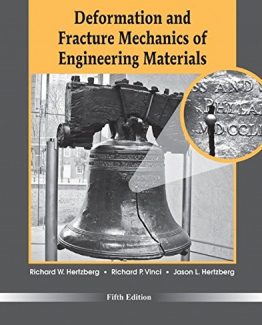Mechanical Measurements 6th Edition by Thomas Beckwith, ISBN-13: 978-0201847659
[PDF eBook eTextbook]
- Publisher: Pearson; 6th edition (August 7, 2006)
- Language: English
- 784 pages
- ISBN-10: 0201847655
- ISBN-13: 978-0201847659
For courses in Measurement and Instrumentation offered in departments of Engineering.
After more than 45 years, the basic purpose of this book can still be expressed by the following three paragraphs extracted from the Preface of the first edition of Mechanical Measurements, published in 1961.
Experimental development has become a very important aspect of mechanical design procedure. In years past the necessity for ”ironing out the bugs” was looked upon as an unfortunate turn of events, casting serious doubts on the abilities of a design staff. With the ever-increasing complexity and speed of machinery, a changed design philosophy has been forced on both the engineering profession and industrial management alike. An experimental development period is now looked upon, not as a problem to avoid, but as an integral phase of the whole design procedure. Evidence supporting this contention is provided by the continuing growth of research and development companies, subsidiaries, teams, and armed services R&D programs.
At the same time, it should not be construed that the experimental development (design) approach reduces the responsibilities attending the preliminary planning phases of a new device or process. In fact, knowledge gained through experimental programs continually strengthens and supports the theoretical phases of design.
Measurement and the correct interpretation thereof are necessary parts of any engineering research and development program. Naturally, the measurements must supply reliable information and their meanings must be correctly comprehended and interpreted. It is the primary purpose of this book to supply a basis for such measurements.
When Tom Beckwith introduced the first edition of this pioneer text in 1961, all sensors and recording equipment were of analog nature. From the first edition to the present sixth edition, we have seen a marked transition from analog measurement to digital measurement. During the time between the first edition and the fourth edition, Tom came to recognize and appreciate the change from analog techniques to digital techniques and this was reflected in the technical material in those editions. However, from the fourth edition to the present edition enormous changes in digital instrumentation have occurred.
In his wildest dreams, we doubt that Tom envisioned how the computer would change the area of mechanical measurements. The personal computer and software such as LabVIEW have revolutionized the measurement process. Instead of cabinet after cabinet of specialized signal conditioning equipment, students may now use a personal computer, with a dedicated interface and appropriate software, to drive array of sensors suitable for most measurements. Although Tom is no longer with us, we are sure that he looks down and smiles when he sees how that which he originally started has progressed.
The authors do not suggest that the sequence of materials as presented need be strictly adhered to. Wide flexibility of course contents should be possible, with text assignments tailored to fit a variety of basic requirements or intents. For example, the authors have found that, if desired, Chapters 1 and 2 can simply be made a reading assignment. Greater or lesser emphasis may be placed on certain chapters as the instructor wishes. Should a course consist of a lecture/recitation section plus a laboratory, available laboratory equipment may also dictate areas to be emphasized. Quite generally, as a text, the book can easily accommodate a two-semester sequence. ACKNOWLEDGMENTS Roy Marangoni thanks his wife, Lavonne, for her patience throughout several editions of this textbook. Roy also expresses his gratitude to his son, Gary, for sharing his expertise in the field of computer technology. John Lienhard would like to thank Lori Hyke and Suzanne Bunker for their assistance with various aspects of the manuscript. John also thanks his family, Theresa, Jasper, and Hannah, for their loving support over the years.
Table of Contents:
Preface xv
Part I Fundamentals of Mechanical Measurement
1 The Process of Measurement: An Overview
2 Standards and Dimensional Units of Measurement
3 Assessing and Presenting Experimental Data
4 The Analog Measurand: Time-Dependent Characteristics
5 The Response of Measuring Systems
6 Sensors
7 Signal Conditioning
8 Digital Techniques in Mechanical Measurements
9 Readout and Data Processing
Part II Applied Mechanical Measurements
10 Measurement of Count, EPUT, Time Interval, and Frequency Measurement of Count, Events per Unit Time, Time Interval, and Frequency
11 Displacement and Dimensional Measurement
12 Strain and Stress: Measurement and Analysis
13 Measurement of Force and Torque
14 Measurement of Pressure
15 Measurement of Fluid Flow
16 Temperature Measurements
17 Measurement of Motion
18 Acoustical Measurements
Part III Appendices
A Standards and Conversion Equations
B Theoretical Basis for Fourier Analysis
C Number Systems
D Some Useful Data
E Stress and Strain Relationships
E.1 The General Plane Stress Situation
E.2 Direction and Magnitudes of Principal Stresses
E.3 Variation in Shear Stress with Direction
E.4 Shear Stress on Principal Planes
E.5 General Stress Equations in Terms of Principal Stresses
E.6 Mohr’s Circle for Stress
E.7 Strain at a Point
F Statistical Tests of Least Squares Fits
Answers to Selected Problems
What makes us different?
• Instant Download
• Always Competitive Pricing
• 100% Privacy
• FREE Sample Available
• 24-7 LIVE Customer Support






Reviews
There are no reviews yet.